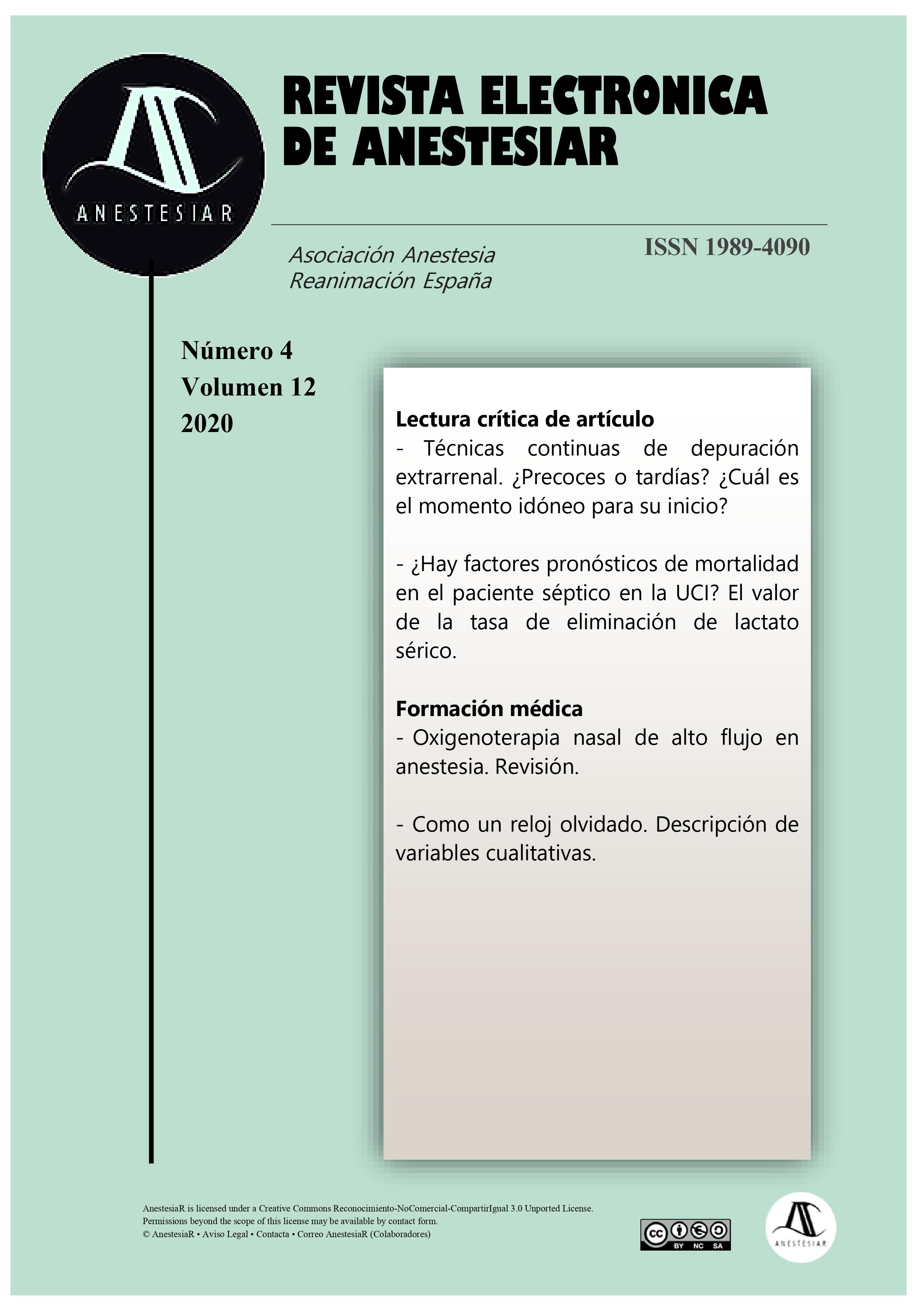Oxigenoterapia nasal de alto flujo en anestesia. Revisión
DOI:
https://doi.org/10.30445/rear.v12i4.800Palabras clave:
HFNO, THRIVE, POINT, HFNC, Terapia nasal de alto flujo, Técnica THRIVEResumen
La terapia con oxígeno nasal de alto flujo es una herramienta relativamente nueva que ha despertado mucha expectación en distintos entornos sanitarios, siendo usada en pacientes con distintas condiciones subyacentes.
Sus ventajas fisiológicas, que la hacen única y el hallazgo de nuevos usos, con posibles aplicaciones en anestesia que podrían suponer importantes implicaciones, sobre todo en el manejo de la vía aérea, han llevado a un interés creciente también en el campo de la anestesiología.
Hemos revisado artículos publicados entre 2015 y noviembre de 2018, tras realizar una búsqueda en Pubmed, sobre todo, orientados en el papel de esta nueva técnica en el periodo perioperatorio.
Además de explicar en qué consiste la técnica, comentamos beneficios fisiológicos (algunos con mayor evidencia científica), indicaciones sobre todo en anestesia (valorando el apoyo científico actual), contraindicaciones, efectos adversos, conclusiones y corrientes actuales. Finalmente acabamos exponiendo una serie de preguntas pendientes de resolver y que requieren más estudios.
Citas
- Badiger S, John M, Fearnley RA, Ahmad I. Optimizing oxygenation and intubation conditions during awake fibre-optic intubation using a high-flow nasal oxygen delivery system. Br J Anaesth 2015;115:629-32
- Nishimura M. High-flow nasal cannula oxygen therapy in adults: physiological benefits, indication, clinical benefits, and adverse effects. Respir Care 2016;61:529-541
- Groves N, Tobin A. High flow nasal oxygen generates positive airway pressure in healthy volunteers. Aust Crit Care 2007;20:126-131
- Cortegiani A, Accurso G, Mercadante S, Giarratano A, Gregoretti C. High Flow nasal therapy in perioperative medicina: from operating room to general ward. BMC Anesthesiol 2018;18:166
- Miguel-Montanes R, Hajage D, Messika J, Et al. Use of high Flow nasal cannula oxygen therapy to prevent desaturation during thacheal intubation of intensive care patients with mild-to-moderate hypoxemia. Crit Care Med 2015;43:574-83
- Mc Narry AF, Patel A. The evolution of airway management- new concepts and conflicts with traditional practice. Br J Anaesth 2017;119:154-66
- Patel A, Nouraei SAR. Transnasal Humidified rapid-insufflation ventilatory exchange (THRIVE): A physiological method of increasing apnoea time in patients with difficult airway. Anaesthesia 2015;70:323-9
- Doyle AJ, Stolady D, Mariyaselvam M, Wijewardena G, Gent E, Blunt M, Young P. Preoxygenation and apneic oxygenation using transnasal humidified rapid-insufflation ventilatory exchange for emergency intubation. J Crit Care 2016;36:8-12
- Gustafsson I-M, Lodenius A, Tunelli J, Ullman J, Fagerlund MJ. Apneic oxygenation in adults under general anesthesia using transnasal humidified rapid-insufflation ventilatory exchange (THRIVE)- a physiological study. Br J Anaesth 2017;118:610-7
- Mir F, Patel A, Iqbal R, Cecconi M and Nouraie SAR. A randomized controlled trial comparing transnasal humidified rapid insufflation ventilatory exchange (THRIVE) preoxygenation with facemask pre-oxygenation in patient undergoing rapid sequence induction of anaesthesia. Anaesthesia 2017;72:439-443
- Chan Lee CH, Perez O, Farooqi FI, Akella T, Shaharyar S, Elizee M. Use of high-flow nasal cannula in obese patients receiving colonoscopy under intravenous propofol sedation: A case series. Resp Med Care Reports 2018;23;118-121
- MS, FM, AFMN. THRIVE? The answer, my friend, is blowing in the (high flow) wind¡ Trend Anaesth Crit Care 2018;22:63-65
- Rajan S, Joseph N, Tosh P, Kadapamannil D, Paul J, Kumar L. Effectiveness of transnasal humidified rapid-insufflation ventilatory exchange versus traditional preoxygenation followed by apneic oxygenation in delaying desaturation during apnoea: a preliminary study. Indian J. Anaesth 2018;62:202-207
- Hengen M, Willemain R, Meyer A, Langer B, Joshi GP, Diemunsch P. Transnasal humidified rapid-insufflation ventilatory exchange for preoxygenation before cesarean delivery under general anesthesia: a case report. A&A case reports 2017;9:216-8
- Shallik N, Zaghw A, Hammad Y. Is the time to update the ASA difficult airway algorithm? Trend Anaesth Crit Care 2018;22:61-62
- Shallik N, Karmakar A. It is time for high flow nasal oxygen to se included in the difficult airway algorithm? Br J Anaesth 2018;121:511-512
Descargas
Publicado
Cómo citar
Número
Sección
Licencia
Derechos de autor 2020 Revista Electrónica AnestesiaR

Esta obra está bajo una licencia internacional Creative Commons Atribución-CompartirIgual 4.0.
 Envío y derechos de autor
Envío y derechos de autor


 Revista Electrónica AnestesiaR by
Revista Electrónica AnestesiaR by 